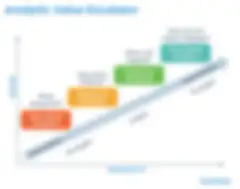Embrace the future — make the move from descriptive to prescriptive analytics
By Jelena Tarbuk


Uncovering insights for your business isn’t easy. You're expected to always do more, do it faster, all without costing a small fortune. But how can you expect the right results when you’re using the wrong kind of analytics?
Let’s explore that a little more. You may have heard of the four different types of analytics (the image below from Gartner helps visualize each type and how they’re used). Depending on when they are used and what questions they help answer, their value to a business increases.
- Descriptive
- Diagnostic
- Predictive
- Prescriptive


Let’s start at the lowest level, hindsight. Now hindsight is an important part of the business process —just think about how many post-mortem meetings you’ve had. We use descriptive analytics to explore what happened. We then typically use diagnostic data to determine why something happened (moving from hindsight to insight). But when is the last time you used predictive data for foresight, to explore what will happen, and then applied prescriptive analytics to put that knowledge into action?
Businesses MUST move their decisions from descriptive to prescriptive - or risk getting left behind as the world of data usage evolves.— Jelena Tarbuk, Senior Sales Director, Talend
The future is prescriptive
Gartner defines prescriptive analytics as “A form of advanced analytics which examines data or content to answer the question ‘What should be done?’ or ‘What can we do to make _______ happen?’ — characterized by techniques such as graph analysis, simulation, complex event processing, neural networks, recommendation engines, heuristics, and machine learning.”
The concept is not just about using your data to answer what happened. This is next-level stuff like predicting what will happen next, then using those insights to anticipate solutions to problems (like Lenovo did here https://www.talend.com/blog/lenovo-predicting-the-future-one-transaction-at-a-time/)
As with most good things, there’s a catch, though. To truly take your analytics from descriptive to prescriptive, you need the right data to begin with. And that’s where things can get dicey.
The AVERAGE number of apps in any given enterprise is 150. 150! That’s a LOT of data points just sitting out there even as SaaS adoption continues to skyrocket. And it probably comes as no surprise that siloed data is the No. 1 data challenge in enterprises. Those silos then affect things like:
- Your time to insight and time to value: How long is it taking you to bring data from yet another new source into your analytics tool?
- Your business decisions: Are they being based on incomplete data?
Your business is at a serious disadvantage without access to datasets that could predict your next rockstar product, offering, customer trend, or even an acquisition channel you maybe haven't thought about. You need those insights TODAY — and leaving the burden for making that happen to an IT team alone isn’t cutting it. Think about the value you could bring to every corner of your organization with faster, deeper, more actionable insights. Now think about this: What could you do if you could bring data together from all sources without relying on IT?
Truth: you can actually take data from nearly anywhere, place it in your cloud data platform of choice (AWS, Snowflake, Azure, Databricks, Google, etc.) in minutes, and get it ready for analysis in a flash with your favorite analytics tools. Sound too good to be true? Learn more here.